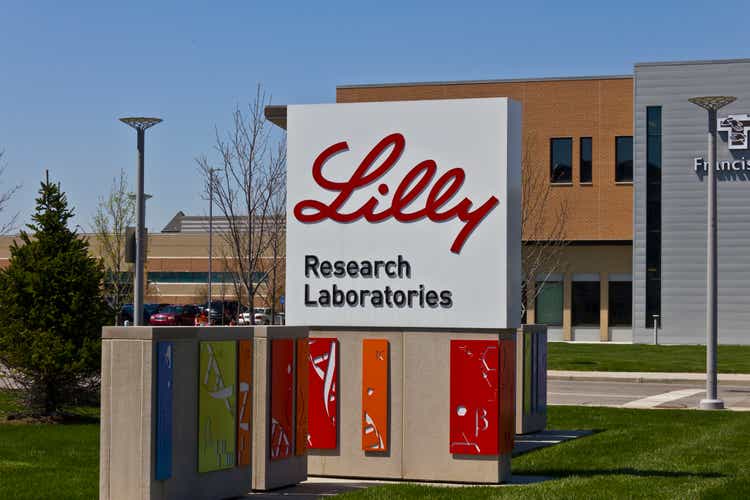Eli Lilly’s Donanemab: Nearing The End Of The Line For Anti-Amyloid Drugs
Summary:
- Anti-amyloid drugs only modestly slow down the progression of Alzheimer’s disease in APOE4 carriers and have no effect on non-carriers.
- APOE4 carriers have more amyloid in their brain so removing the amyloid slows down their progression closer to non-carriers.
- Removing amyloid, though, can cause brain bleeds and swelling.
- Depending on how the FDA and Medicare decide on donanemab the stock value of Eli Lilly might either go up or down by 100 points.
- Certain anti-oxidant treatments for Alzheimer’s disease are likely to be much more effective than anti-amyloid treatments.
jetcityimage
Eli Lilly (NYSE:LLY) made a recent, critical announcement regarding its anti-amyloid drug donanemab that did not receive the attention that it deserved. Donanemab only significantly reduced the progression of Alzheimer’s disease in APOE4 carriers. The comparison with other anti-amyloid drugs establishes a pattern that is difficult to deny.
Eli Lilly’s donanemab (removes a form of plaques that leads to the increased production of amyloid oligomers).
Relationships between amyloid reduction and iADRS scores were significant in APOE4 carriers, but not in participants without APOE4, which may be due to relatively few noncarriers in TRAILBLADER-ALZ or pharmogeneomic differences in treatment response, the researchers noted (acknowledgment, earlier results).
Biogen/Eisai’s (BIIB) (OTCPK:ESALY) aducanumab/Aduhelm (primarily removes amyloid plaques, but also removes amyloid oligomers) at highest dose in “successful” study:
- Numerically worse than placebo on first key secondary and numerically less effect than carriers on all 4 endpoints (FDA statistician report, p. 12).
Eisai/Biogen’s Ban2401/lecanemab (removes amyloid oligomers):
- APOE4 carriers declined 63 percent less and noncarriers only 7 percent less [on ADSCOM] (results).
Alzheon’s ALZ-801/tramiprosate:
- Highest efficacy was observed in APOE4/4 homozygotes…showing statistically significant effects on ADAS-cog and positive trends on CDR-SB (respectively, 40 to 66% and 25-45% benefit compared to placebo). APOE4 heterozygotes showed intermediate efficacy, and non-carriers showed no benefit (results).
And here in a nutshell is the key to understanding the role of amyloid in Alzheimer’s disease: removing amyloid oligomers or preventing their buildup modestly slows down the progression of Alzheimer’s disease in its early stages, but only in APOE4 carriers. Even if such treatments begin before the onset of Alzheimer’s disease and even if almost all amyloid is removed or blocked it does not matter. The reason for this is that APOE4 carriers have more amyloid oligomers in their brain than non-carriers, and this extra amyloid makes carriers progress more rapidly than non-carriers at least during the early stages of Alzheimer’s disease (study). Removal of oligomers (or plaques that contribute to the formation of oligomers) slows down the progression of early Alzheimer’s disease in APOE4 carriers closer to that of non-carriers, but at the risk of brain bleeds and brain swelling.
A recent article posed this question: If amyloid drives Alzheimer’s disease, why have anti-amyloid therapies not yet slowed cognitive decline? The simple answer is that amyloid is not the primary driver of Alzheimer’s disease and that is why anti-amyloid therapies have not slowed cognitive decline in non-APOE4 carriers. A whole slew of other factors act as primarily triggers for the disease by increasing oxidative and nitrostative stress; amyloid is both a product of these other triggers, and then acting via some of the same receptors as the primary triggers can add to that oxidative and nitrostative stress. These initiating agents include exposure to environmental toxins (such as air pollutants, pesticides and herbicides, industrial solvents, and heavy metals), an unhealthy diet (high in sugar and other carbohydrates, high fructose corn syrup, saturated fats, etc.), lifestyle choices (heavy smoking and drinking, for instance), chronic bacterial, viral, and fungal infections, and psychological stress. Genetic factors such as the APOE4 gene and presenilin gene mutations can magnify the effects of these primary triggers leading in some or all cases to the onset of the disease depending on the gene.
With this background, the reasons why anti-amyloid drugs have not worked particularly well and why some people have considerable amounts of amyloid in their brain but do not develop Alzheimer’s disease come into sharper focus. The following titles and articles provide the central answers:
- Protection against Amyloid-β Oligomer Neurotoxicity by Small Molecules with Antioxidative Properties: Potential for the Prevention of Alzheimer’s Disease Dementia (full article)
- Bolstered Neuronal Antioxidant Response May Confer Resistance to Development of Dementia in Individuals with Alzheimer’s Neuropathology by Ameliorating Amyloid-β-Induced Oxidative Stress (full article)
Indeed, the use of certain antioxidant natural products and drugs have largely stabilized Alzheimer’s disease, often for periods of two years or more. This includes Korean red/panax ginseng (first trial, second trial), aromatherapy (first trial, second trial), and Anavex’s (AVXL) blarcamesine (presentation, p. 38).
What does all this mean for anti-amyloid drugs in general, and Eli Lilly specifically? First if they are approved at all, anti-amyloid drugs should only be approved for early stage Alzheimer’s patients who have the APOE4 gene or genes. Secondly Alzheon’s ALZ-801, while producing similar results in terms of cognition as donanemab, lecanemab, and Aduhelm has two major advantages over its competitors: it is taken orally rather that intravenously and it does not cause brain bleeds and brain swelling. In some individuals, particularly with two copies of the APOE4 gene it may produce a clinically significant slowing down in Alzheimer’s disease. The best hope for those with Alzheimer’s disease, though, is in treatments that act as direct antioxidants.
Calculating what the FDA will do with Eli Lilly’s donanemab and what effect this will have on the company’s stock price is challenging (the following analysis also applies with slightly less upside and slightly more downside to Biogen in regards to lecanemab). If the FDA approved the drug for all early Alzheimer’s disease patients (which again it should not do), and if the anticipation is that Medicare would follow suit Eli Lilly’s stock value would likely increase to over 400 points (as happened with Biogen/Eisai’s aducanumab after FDA approval). However, if the FDA fails to approve donanemab, Eli Lilly’s stock value should drop to the low to mid 200s. Eli Lilly has enough promising assets that there should not be a massive drop in its stock value following an FDA denial. The wildcard is how investors would respond to an approval for just APOE4 carriers. That is still a very large market, but might be a slight disappointment. Maybe a small drop would follow such a decision.
Even with FDA approval, Medicare could decide that since there appears to be only a slight difference in the cognitive impact of anti-amyloid drugs and since safety issues remain with all of them except ALZ-801, donanemab and lecanemab should not be covered. This would once again infuriate Alzheimer’s organizations and other patient advocacy groups, but would be a rational decision based on the limited efficacy and safety concerns surrounding drugs that remove amyloid. Indeed, powerful forces have done no favor to either Alzheimer’s patients or to their caregivers by overstating the effectiveness of these medications. For their part, pharmaceutical companies have sometimes employed a kind of statistical sleight of hand to obscure that only one group experiences a modest benefit from amyloid removing drugs. But they are also the group most likely to experience potentially devastating side effects from these drugs.
The bigger picture is that we are near the end of the amyloid era for Alzheimer’s disease. Once resources and minds are sent in a more productive direction, the future of Alzheimer’s treatments is bright.
Disclosure: I/we have no stock, option or similar derivative position in any of the companies mentioned, and no plans to initiate any such positions within the next 72 hours. I wrote this article myself, and it expresses my own opinions. I am not receiving compensation for it (other than from Seeking Alpha). I have no business relationship with any company whose stock is mentioned in this article.

